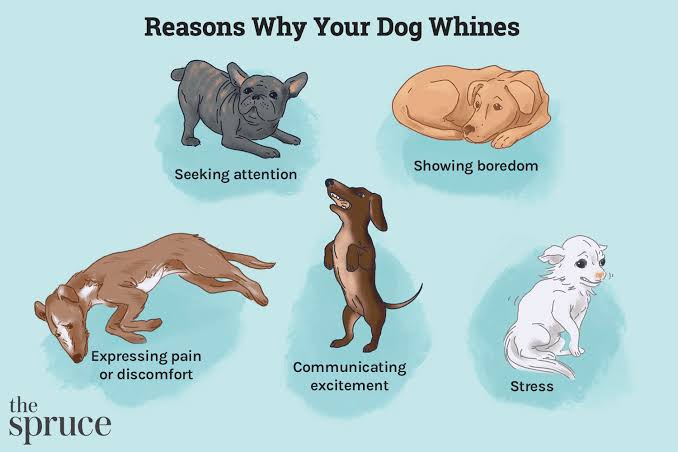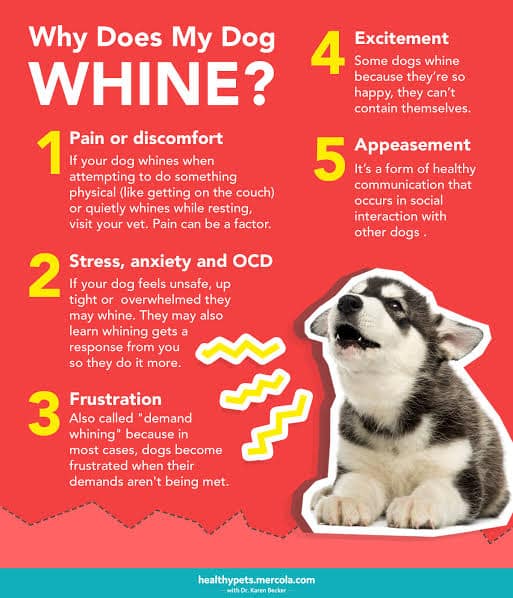Dogs have the incredible ability to communicate with humans in various ways, and one of the most common methods they use is whining. But in this article, we will really answer the question “Why Do Dogs Whine?”. As we proceed into this article, we will analyze the reasons why dogs whine and explore the various motivations and meanings behind this vocalization.
Overview Of Why Dogs Whine
When a dog whines, it can evoke a range of emotions in their human companions, from annoyance to concern. But why do dogs whine? Is it simply a form of attention-seeking behavior, or is there something more behind it?. By understanding why dogs whine, we can better interpret and respond to their needs, strengthening the bond between human and canine companions.

Understanding Why Dogs Whine
We all know that dogs can’t exactly communicate with words like we can, so sometimes they resort to whining to get their message across.
One common reason why dogs whine is because they want attention. Yep, they’re just like our little attention-seeking siblings. Sometimes all they want is a little pat on the head or a belly rub, so they’ll let out a little whine to let you know they’re there and ready for some love.
Another reason dogs may whine is because they’re anxious or scared. Maybe they’re uncomfortable in their environment or they’re feeling a bit nervous about something. They may let out a whine to show that they’re feeling uneasy or to ask for reassurance. It’s important to pay attention to their body language and see if there are any other signs of anxiety or fear alongside the whining.
More Information
Sometimes, dogs also whine because they’re bored or frustrated. Maybe they’re craving some playtime or they’re tired of being cooped up inside. In these cases, a nice long walk or some interactive toys can do wonders to keep them entertained and quiet.
It’s also worth mentioning that some dogs are just natural-born whiners. They have a tendency to vocalize their every thought and feeling, kind of like those people who never stop talking. It’s just part of their personality and something that they may do more often than others.
Medical Issues That Cause Whining In Dogs
Whining in dogs can be a sign of various medical issues that need to be addressed. While some dogs may whine for attention or out of anxiety, it is important to rule out any underlying medical conditions that may be causing this behavior. In this section, we will discuss some of the common medical issues that can cause whining in dogs.
One of the main medical issues that can cause whining in dogs is pain. Dogs may whine if they are experiencing any kind of discomfort, such as from an injury or a chronic condition like arthritis. It is important to closely observe your dog’s behavior and look for signs of pain, such as limping or a reluctance to move. If you suspect that pain is causing your dog to whine, it is essential to consult with your veterinarian for proper diagnosis and treatment.
Another medical issue that may cause whining in dogs is gastrointestinal problems. Dogs with upset stomachs, gastrointestinal blockages, or other digestive issues may exhibit whining as a symptom. If your dog’s whining is accompanied by vomiting, diarrhea, or loss of appetite, it is crucial to seek veterinary attention to determine the underlying cause and provide appropriate treatment.
Furthermore, whining can also be a sign of discomfort or distress related to respiratory difficulties. Respiratory conditions such as asthma or allergies can cause whining due to trouble breathing or congestion. If your dog’s whining is accompanied by wheezing, coughing, or shortness of breath, it is important to have them evaluated by a veterinarian to determine the cause and prescribe the necessary treatment.

More Information
Lastly, whining can be a symptom of various other medical issues, including urinary tract infections, dental problems, or neurological disorders. If your dog’s whining is persistent and unexplained, it is vital to schedule a veterinary examination to rule out any underlying medical conditions.
When it comes to our beloved furry friends, it’s important to know that whining can be a sign of underlying medical issues. While dogs may whine for various reasons, such as boredom or seeking attention, it’s crucial to rule out any potential health problems as well.
Identifying Signs Of Distress In Your Dogs
It is crucial to be able to recognize signs of distress in our furry friends. Dogs, like humans, can experience stress and anxiety, and it is our job to identify these signs and address them promptly. By being knowledgeable about the signs of distress in your dog, you can provide the necessary care and support to ensure their well-being.
One common sign of distress in dogs is excessive panting. If you notice your dog panting excessively, even when they haven’t engaged in any physical activity, it could be a sign of stress. Other signs to look out for include trembling, restlessness, and excessive grooming or scratching. These behaviors can indicate that your dog is feeling anxious or uncomfortable in their environment.
Another important sign of distress to be aware of is changes in appetite or eating habits. If your dog suddenly starts to lose their appetite or refuses to eat altogether, it could be a sign of physical or emotional distress. It is essential to monitor their eating patterns and consult with a veterinarian if you have any concerns.
Changes in behavior can also be indicative of distress in dogs. If your typically friendly and outgoing dog suddenly becomes withdrawn or aggressive, it may be a sign that something is bothering them. Monitor their behavior closely and try to identify any triggers or changes in their environment that may be causing their distress.
See Also: Senior Dogs Arthritis Exercises
Additional Details
It is worth noting that the signs of distress can vary depending on the individual dog and the situation they are in. Some dogs may exhibit more subtle signs, such as excessive yawning or pacing, while others may display more obvious signs like barking or whining. It is crucial to pay attention to your dog’s behavior and look for any deviations from their normal patterns.
If you notice any signs of distress in your dog, it is essential to address the issue promptly. Providing a safe and calm environment for your dog, engaging them in physical exercise, and offering mental stimulation can help alleviate their stress. Additionally, consulting with a veterinarian or a qualified dog behaviorist can provide further guidance and support in managing your dog’s distress.

Addressing And Managing Dog Whining Behavior
Whining is a common behavior in dogs, and as a responsible pet owner, it is important to address and manage this behavior. Whining can be a sign of various things, such as anxiety, attention-seeking, or discomfort. Understanding the underlying reason for your dog’s whining can help you develop effective strategies to address it.
First, it is important to rule out any medical issues that may be causing your dog’s whining. Pay a visit to your veterinarian to ensure that your dog is in good health. If medical issues are ruled out, you can focus on behavioral strategies.
One approach to managing whining behavior is to ignore it. Dogs often whine to get attention, and if you respond by giving attention, you may inadvertently reinforce the behavior. By ignoring the whining and only giving attention when your dog is calm and quiet, you can teach them that whining will not get them what they want.
Another strategy is to redirect your dog’s attention. If your dog is whining because they are anxious or bored, providing them with an appropriate outlet for their energy can help. Engage them in interactive play, provide puzzle toys, or take them for regular walks to stimulate their mind and body.
More Information
Training your dog to have a “quiet” command can also be beneficial. Teach your dog to understand that being quiet is rewarded with treats or praise. Practice this command in various situations where your dog tends to whine, gradually increasing the distractions to test their progress.
Consistency is key when addressing and managing whining behavior. Ensure that all family members are on the same page when implementing strategies and avoid inadvertently reinforcing the behavior by giving in to your dog’s demands when they whine.
If you find that your efforts to address and manage your dog’s whining behavior are not effective, it may be beneficial to seek help from a professional dog trainer or behaviorist.
Remember, addressing whining behavior requires time, patience, and consistency. With proper training and management techniques, you can help your dog develop better coping mechanisms and reduce their whining behavior.

Seeking Professional Help For Excessive Dog Whining
Excessive whining in dogs can be a challenging issue to address, but seeking professional help is a crucial step in finding a solution. Whining is a form of communication for dogs, but when it becomes persistent and excessive, it can indicate an underlying issue that needs attention.
Professional help can come in the form of a qualified and experienced dog trainer or a veterinary behaviorist. These professionals have the expertise to assess the situation and develop a customized plan to address the excessive whining behavior in your dog.
During the evaluation process, the professional will consider various factors such as the dog’s breed, age, medical history, and living environment. They may also want to assess the dog’s overall behavior and temperament to gain a comprehensive understanding of the situation.
Once a thorough assessment is conducted, the professional will work with you to develop a behavior modification plan tailored to your dog’s specific needs. This plan may involve a combination of training techniques, environmental changes, and potential medical interventions if necessary.
See Also: How to get Dog Hair Out of the Car: See the Easiest Method
FAQs
Why Do Dogs Whine?
Dogs may whine for various reasons, including seeking attention, expressing anxiety or fear, signaling discomfort, or as a means of communication. Understanding the context and accompanying behaviors can help identify the specific cause.
Is Whining Normal Behavior For Dogs?
Yes, whining is a normal form of canine communication. It’s a way for dogs to express their needs, emotions, or discomfort. However, excessive or sudden changes in whining behavior may warrant attention and investigation.
How Can I Interpret My Dog’s Whining?
Context is crucial. Pay attention to the situation, body language, and accompanying cues. Whining during play may indicate excitement, while whining near the door could signal a desire to go outside.
Can Medical Issues Cause Whining In Dogs?
Yes, pain or discomfort due to underlying medical conditions can lead to whining. If your dog’s whining is persistent, consult with a veterinarian to rule out any health concerns.
How Can I Address Excessive Whining In My Dog?
Identify the cause first. If it’s attention-seeking behavior, avoid reinforcing it. For anxiety-related whining, consider creating a calm environment or using positive reinforcement techniques.
Do Different Breeds Whine More Than Others?
While individual dogs vary, some breeds are known for being more vocal. Breeds like hounds or terriers, for instance, may have a natural inclination to vocalize. However, training and individual temperament play significant roles.
Can Separation Anxiety Cause Whining?
Yes, dogs experiencing separation anxiety may whine as a response to being left alone. Implementing gradual desensitization techniques, providing engaging toys, or seeking advice from a professional can help manage separation anxiety.
At What Age Do Puppies Typically Outgrow Whining?
Puppies may whine as a form of communication, and it’s a normal part of their early development. As they mature and learn alternative ways to express themselves, whining often diminishes. However, individual differences exist.
Should I Ignore My Dog’s Whining?
It depends on the cause. If your dog is whining for attention and you give in, it may reinforce the behavior. On the other hand, addressing whining due to anxiety or discomfort with appropriate care is essential.
When Should I Seek Professional Help For My Dog’s Whining?
If your dog’s whining is sudden, persistent, or accompanied by behavioral changes, consulting with a veterinarian is recommended. Professional dog trainers or behaviorists can provide guidance for specific issues like separation anxiety or excessive vocalization.
Conclusion
In conclusion, dogs whine for a variety of reasons, including seeking attention, expressing anxiety or fear, and physical discomfort. It is essential to understand the underlying cause of a dog’s whining behavior to address it effectively. While this article has provided a general overview of the reasons behind dogs whining, further research and consultation with professionals can provide valuable insights into specific cases. By conducting more research, you can gain a deeper understanding of dog behavior and take appropriate steps to address whining in your furry companion.

